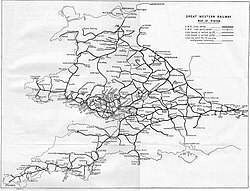GWR road motor services

The Great Western Railway road motor services operated from 1903 to 1933 by the Great Western Railway, both as a feeder to their train services, and as a cheaper alternative to building new railways in rural areas. They were the first successful bus services operated by a British railway company.
History
Faced with an estimate of £85,000 to build a light railway to serve the area south of Helston in Cornwall, the Great Western Railway (GWR) decided to test the market with bus services on the route. They learnt that the Lynton and Barnstaple Railway had been forced by local officialdom to cease using the two buses on their pioneering connection to Ilfracombe and so the GWR bought them to operate a Helston service. The service proved so popular and profitable that further routes were soon established at Penzance and Slough.
By the end of 1904, 36 buses were in operation, 10 more than were in service in
Vehicles

The first vehicles were 16 hp Milnes-Daimler single-deck buses. They were soon supplemented by 20 hp, and later, 30 hp vehicles from the same company. Smaller numbers of vehicles were also supplied by
Buses for busier routes were double-deck, while some had luggage compartments for carrying mail bags. For tourist excursions, vehicles – known as "Jersey Cars" – were open, with seats arranged in tiers so that passengers sitting at the back could see over the heads of those in front. More familiar coach types were introduced later and were used on excursions and long-distance "Land Cruises".
Services in Devon and Cornwall
Routes in
Helston and Penzance
The first service ran from
service via Helston was run from 11 July 1921.A service from Penzance to
Bus services today at Penzance continue to use a bus station adjacent to Penzance railway station.
Plymouth and the South Hams
A service from Plymouth to Modbury was introduced later in 1904, with several local services from Modbury to Aveton Gifford, Yealmpton, Bigbury-on-Sea, and Ivybridge. They also ran through Kingsbridge to Salcombe and Dartmouth. Further routes from Kingsbridge ran to Totnes, Newton Abbot, Thurlestone and Hope Cove.
A Plymouth to Roborough route ran from 12 September 1904 until 6 August 1916. Buses were kept underneath the viaduct upon which Plymouth Millbay railway station was built.
Torquay and Paignton
A service was introduced along the sea front, linking Paignton with Torquay on 11 July 1904. Another route was established from Paignton to Totnes on 20 April 1905, as well a short-lived one to Brixham, and seasonal tours.
The bus station at Paignton is still opposite Paignton railway station.
Redruth
Services from Redruth started on 29 July 1907 with a route to Falmouth. A network was established over the coming years that reached to Portreath, Illogan, St Day, Carharrack, St Keverne, and Helston.
The
St Austell
The first services from St Austell were that to St Columb Road via St Dennis on 3 August 1908 and to Bugle and Bodmin the following month. Other routes were added to Charlestown, Pentewan (3 August 1908), Newquay (29 May 1910), Truro (1911), Trenarren (1 August 1911), St Blazey, Treviscoe (2 October 1911), Par (1 October 1920), Tywardreath and Fowey, also Portscatho (9 October 1923), Mevagissey (17 December 1923), Gorran Haven, Roche (9 July 1928).
The bus station at St Austell is still situated outside St Austell railway station in what used to be the railway goods yard.
Other services
A service ran from
Services elsewhere in England
Slough

One of the railway's earliest routes was that from Slough railway station to Beaconsfield, Buckinghamshire, opened on 1 March 1904. Routes to Windsor followed on 18 July 1904 and to Burnham Beeches on 1 May 1908, extended to Taplow in 1927.
Cotswolds
Services from
Somerset
Some steam buses were tried at Highbridge railway station to work a Burnham-on-Sea to Cheddar service during 1905. The following year a number of services were tried that radiated from Bridgwater, but all had been withdrawn by the end of 1911.
Services were run in Weston-super-Mare along the sea front to the Old Pier and Sand Point, and up the hill to Worlebury. Commencing on 8 July 1928, they continued under GWR operation until 19 July 1931 when they were transferred, along with some routes in Portishead, to Bristol Tramways, which is now First West of England.
Other services
A route from Wolverhampton to Bridgnorth was operated for a short while from 7 November 1904 using steam buses, and was restarted the following year with motor buses. Stourbridge was linked with Bromsgrove, a town on the Midland Railway, on 13 February 1905.
In the Weymouth area, services started in 1905 jointly with the London and South Western Railway. These, the last services operated by the railway, were transferred to the Southern National company on 1 January 1934.
Other routes could be found at Banbury, Frome, Hungerford, Maidenhead, Marlborough, Newbury, Swindon, and Wantage.
Routes were transferred to various local companies, with the railway taking a shareholding to allow it to exert an influence over the bus services, although routes were often transferred over a period of several months following the signing of the agreements on the dates given. Companies involved were the Birmingham and Midland Motor Omnibus Company (Midland Red – 1 January 1930), City of Oxford Motor Services (28 February 1930), Thames Valley Traction (1 January 1931), although some of those at Slough went to London General Country Services on 10 April 1932. Routes around Swindon were transferred to Bristol Tramways.
Services in Wales
Services started from
Services in south and west
References
- Cummings, John (1980). Railway Motor Buses and Bus Services in the British Isles 1902–1933, volume 2. Headington: Oxford Publishing Company. ISBN 0-86093-050-5.
- Kelley, Philip J (1973). Road Vehicles of the Great Western Railway. Headington: Oxford Publishing. ISBN 0-90288-812-9.





